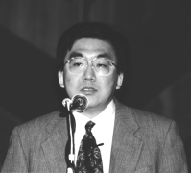
| Koji Fujimoto Assistant Director Electronics Policy Division Machinery and Information Industries Bureau Ministry of International Trade and Industry |

| Koji Fujimoto Assistant Director Electronics Policy Division Machinery and Information Industries Bureau Ministry of International Trade and Industry |
I have the responsibility for the Real World Computing Project at the Ministry of International Trade and Industry. First, I would like to thank all of you for your continuous cooperation and understanding in regards to this project. The 10-year project has already finished its first five years, or you could say that it still has five more years to go. The interim reports presented during this 1997 Real World Computing Symposium will surely make us decide to attempt even greater achievements during the second half.
Next, I would like to explain the basic policy that the Ministry of International Trade and Industry, or MITI, employs in order to manage this project. (Fig. 1)
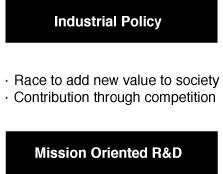
Fig. 1
The Japanese government has many ministries and agencies. As one of the administrative organizations, MITI's primary mission is to establish and implement Japanese industrial policy. It is for certain that the definition ofgindustrial policyhcould change as the times proceed and people will have a variety of views and opinions from time to time. So, what I'm going to tell you is not our government's official position. What I would like to describe is the industrial policy that MITI applies particularly to the operation of the Real World Computing Project.
In terms of research and development activities, MITI's industrial policy is to create a competition in which the one who first provides new value to our society is the winner. Contributing to the development of the world through such competition and providing an appropriate environment for the competition is our mission. We therefore cannot accept any research projects that are without specific purposes. As long as a project is operated by MITI's subsidiaries, it must be in compliance with our industrial policy. In other words, projects funded by MITI should participate via competition to provide new value to our society. Research and development activities by the ministry can be said to be mission-oriented. This is the underlying idea for this project's operation.
We spent almost one year determining the fundamental course that the second half of the Real World Computing Project should follow. During that period we discussed, reported, and consulted with many researchers at the Real World Computing Partnership or RWCP, representatives of RWCP Member companies, and faculty members of cooperating universities. Taking advantage of this symposium, I would like those of you who are engaged in this project to overview the project again. I hope my speech will be of some help to those of you who are interested in the project in understanding the future course for the second half and how we will proceed.
I would like to begin with the development of our discussion over the RWC Project's future course. The Evaluation and Promotion Committee, an independent advisory group which evaluates and advises on the promotion of the RWC Project, accepted a proposed plan for the second half of the Project in March 1996. Immediately after MITI obtained the committee's acceptance, we started workshops and established working groups to deliberate the basic guidelines for narrowing research subjects and instituting a better system for the project.
Following these preliminary discussions, a preparatory meeting for Fundamental Information Technology of the Next Generation was held under the chairmanship of Professor Hidehiko Tanaka of the University of Tokyo, and an overall framework was unofficially decided at the meeting. Prof. Tanaka already presented the conclusion of the preparatory meeting on the first day of this symposium, so I do not think it is my mission to explain the contents of that meeting in detail. The most important points I would like to make clear are MITI's ideas and planned structure for better management in order to more effectively conduct this project.
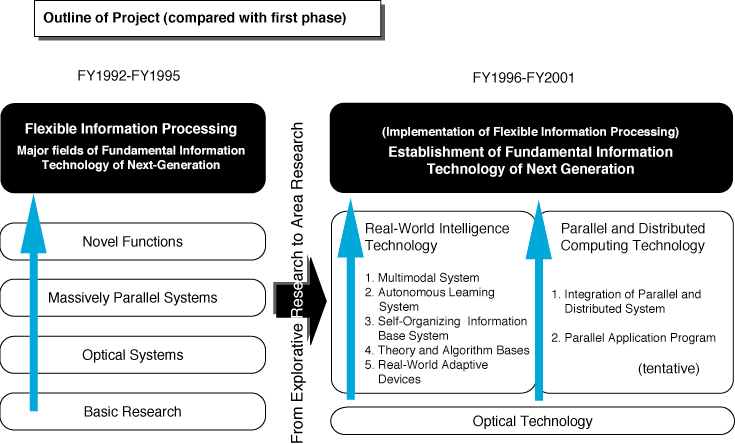
Fig. 2
The left part of this chart (Fig. 2) shows the structure for the project's first five years.
During the first half of the project, very basic and exploratory research activities were carried out in many fields in order to achieve flexible information processing. As dubbed thegYatsugatake methodhor multi-peak-mountain-range method, as it did not have a single, common goal.
Since this was a single project calledgReal World Computing Project,hand its goal was to establishgflexible information processing,hsome expected that the project was to be managed under a common goal to develop an integrated system over the whole 10 years time, while others believed that the exploratory activities would be conducted independently with their own goals. I am afraid that we were not able to balance the two different positions, mainly because RWC research activities were very difficult to achieve and control. That was the situation at the end of the first five years of the Real World Computing Project.
What we would like to focus on for the project's second half is the way we conduct research activities in each research area. We believe that each activity should be conducted independently. It's not necessary to manage them collectively under a common, single goal. It is not our intention to force all researchers and research groups to proceed on the same track, stepping together towards a single goal, or to make a common achievement by the end of the project in 2002. In the field of technology, the project's arrangement will automatically lead to successful results when each research activity is conducted with its own purpose in an appropriate manner. Fundamental information technology will be established when the purposes or missions of the individual activities are satisfied.
We therefore decided on two main project areas which will include all project activities. The two main project areas do not have to share a common goal. Rather, it will be a single project with two-folded goals, as the two main project areas advance to make breakthroughs and fulfill their respective missions. It can be said that we have two sub-projects. Combining the two sub-projects constitutes our entire project which is geared towards the establishment of Fundamental Information Technology of the Next Generation.
I am afraid that the project's name, Fundamental Information Technology of the Next Generation, might be too broad and does not allow everyone to obtain a specific picture of the project. The Ministry of International Trade and Industry believes that next-generation and important technology for the information industry to begReal World Intelligence TechnologyhandgParallel and Distributed Computing Technology.hIt was based on these beliefs intended to use the title they chose. MITI's basic approach is to allow the two technology areas or sub-projects to have their own missions and advance in their most appropriate ways. As for the details about the two sub-projects, Dr. Junichi Shimada, Director of the RWCP Research Institute, and Dr. Nobuyuki Otsu, Director of the Machine Understanding Division of the Electrotechnical Laboratory, will cover them in their speeches later.
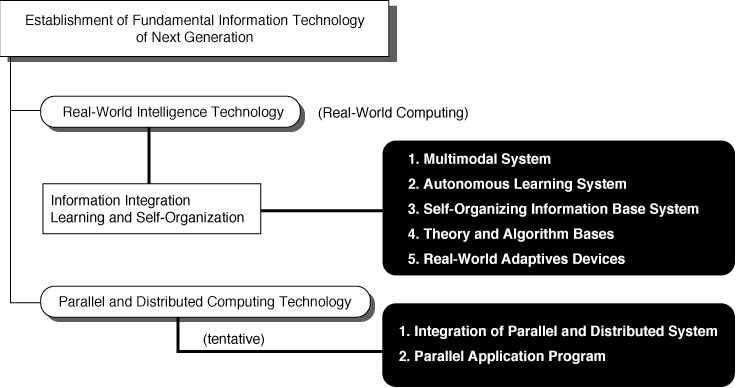
Fig. 3
This chart (Fig. 3) is an enhanced version of the previous one showing the second half of the RWC Project in detail.
As you can see, there are twogsub-projectshunder the overall project name,gEstablishment of Fundamental Information Technology of the Next Generation.hSome of you might ask where the project name for the first half,gReal World Computing,hhas gone. The Real World Computing Project will be succeeded by thegReal World Intelligence Technologyhsub-project and the linkage of the two project halves is indicated by the fact that the sub-project will be nicknamedgReal World Computinghas well. When software researchers who have been engaged in algorithm research under the theme ofgflexible information processinghjoin the second half of the project, it can be said that they are still working for the Real World Computing Project.
ThegParallel and Distributed Computing Technologyhsub-project is a tentatively defined initiative. During the past year, our discussion on the Real World Intelligence Technology has considerably advanced, and a consensus is forming on the area definition of one sub-project. We have not reached a consensus on the area definition of the other sub-project and discussions are still going on concerning if it should proceed with the two existing research areas or if one more area, for example, advanced computing technology, should be added. So, it has not yet been finalized. Also, some have suggested that the Parallel and Distributed Computing Technology sub-project should have a nickname equivalent togReal World Computinghas does the Real World Intelligence Technology.
On the whole, the second half of the project will proceed virtually as two projects under a single concept. There will be many research areas within the framework of the two sub-projects and individual researchers will belong to one area and employ the most effective methodologies to accelerate their research and achieve breakthroughs. That is our intended style of project operation.
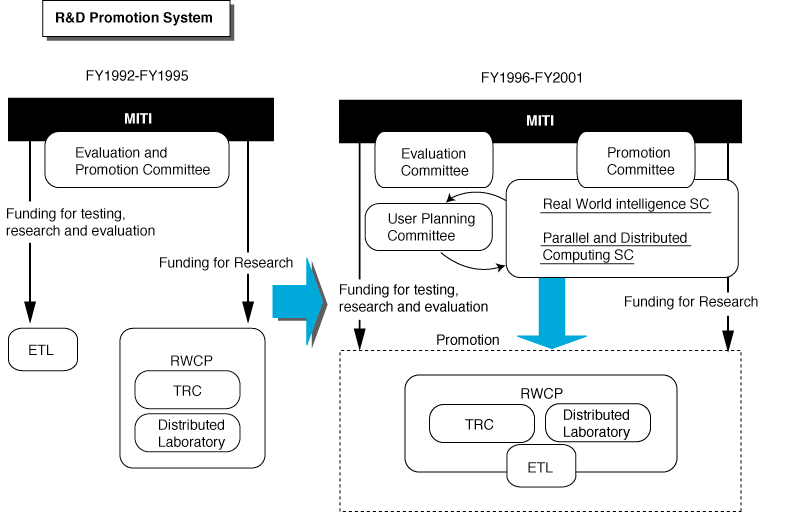
Fig. 4
I've been talking about the contents of our project and what we hope to do. How it will be carried out is illustrated in this chart (Fig. 4). The left part is the system of the project's first half and the right side is the system for the second half.
For the first half of the Project, we had the Evaluation and Promotion Committee. The Electrotechnical Laboratory took the responsibility for leading-edge research and MITI consigned research activities to the Real World Computing Partnership. The Tsukuba Research Center was established under the RWCP and member companies served as satellite laboratories.
For the next half, the two sub-projects are clearly defined and five years will be allowed for individual research activities. We will establish two committees: the Promotion Committee and the Evaluation Committee. The Promotion Committee will decide on the method for conducting research and the Evaluation Committee will evaluate each research activity every year.
As shown in the chart, subcommittees will be established under the Promotion Committee; they will be the Real World Intelligence Subcommittee and the Parallel and Distributed Computing Subcommittee. All of these committees and subcommittees will be established under the Ministry of International Trade and Industry.
We plan to ask Professor Tanaka to take the chair of the Promotion Committee. That is why we requested him to chair the preparatory meeting. Dr. Otsu of the Electrotechnical Laboratory and Dr. Shimada of the Real World Computing Partnership are our candidates for the chairs of the Real World Intelligence Subcommittee and the Parallel and Distributed Computing Subcommittee, respectively. The reason for their nomination is that these candidates will make full use of their extensive expertise in order to advance the research of their respective areas.
How will each research result be implemented then? It is planned to create an RWC Promotion Center in the Electrotechnical Laboratory. The Promotion Center also belongs to MITI and Dr. Otsu of the Electrotechnical Laboratory will be appointed as director. The Promotion Center will make research plans as the leading organization of the Real World Intelligence sub-project. In as much as its activities will be changed, the English title, Real World Computing Partnership, or RWCP, may be changed as well. If you let me call it the Real World Computing Partnership or RWCP for the sake of convenience, then the Tsukuba Research Center or TRC and satellite laboratories are established within RWCP. On the other hand, RWCP's laboratories and the RWC Promotion Center in the Electrotechnical Laboratory will jointly implement the research results of the Real World Intelligence by keeping closer contact with each other. In this field, therefore, the RWC Promotion Center in the Electrotechnical Laboratory will play a leading role in preparing research plans for the satellite laboratories and TRC, upon consultation with Dr. Shimada of the RWCP.
In the field of Parallel and Distributed Computing, we do not plan to establish a Promotion Center in the Electrotechnical Laboratory but the RWCP will assume a key role in the implementation of its research results.
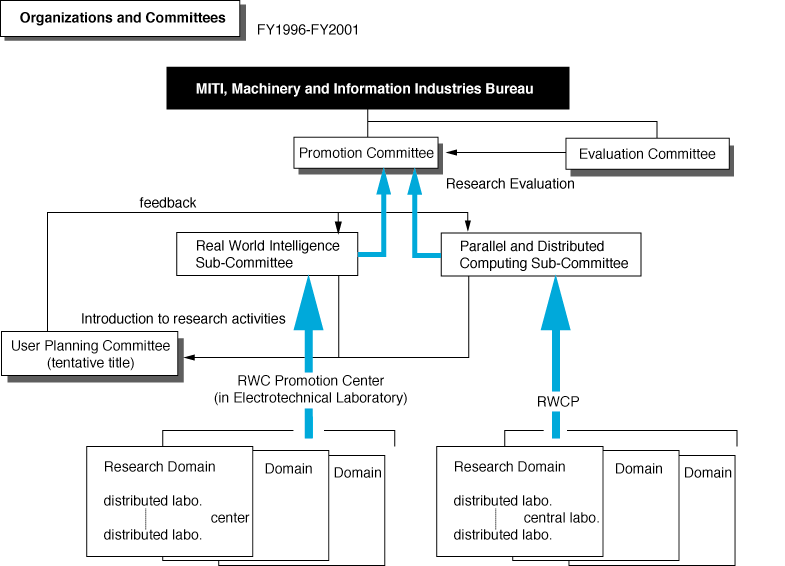
Fig. 5
This chart (Fig. 5) illustrates my explanation in detail. Under the Ministry of International Trade and Industry, the Evaluation Committee and Promotion Committee will be established. The Evaluation Committee will annually evaluate every research activity at the end of the project year during the second half, and provide their conclusions to the Promotion Committee. The Promotion Committee has two subcommittees; the Real World Intelligence Subcommittee and the Parallel and Distributed Computing Subcommittee.
The User Planning Committee is tentatively named and the title may be possibly changed. Its mission has not definitely been determined. Since a number of private companies have joined this project, we would like to provide people who are in charge of product planning and business planning at member companies with the opportunity to review and evaluate research activities of the project through this committee. So, they will not directly take part in decision making for research and development activities but will be able to make comments from various perspectives.
The supporting bodies for the two subcommittees will be the research organizations in both fields; the RWCP Tsukuba Research Center will work as the hub for Parallel and Distributed Computing activities and the Promotion Center at the Electrotechnical Laboratory will serve as the center of Real World Intelligence initiatives. This is the outline of the system for the project's new phase which will begin April 1997.
Let me explain the relationship between the RWCP laboratories and the Promotion Center in terms of this chart (Fig. 5). The Promotion Center is MITI's own research. In the field of Real World Intelligence, RWCP laboratories, that is, Members laboratories, will consult with the Promotion Center in order to make research plans. Dr. Shimada of the RWCP will, therefore, be a key character and keep in touch with the Promotion Center so helping conduct their research according to fixed plans.
As I stated, the overall system including the basic strategy regarding how to make research plans is now taking its shape. The remaining issue is what is going to be studied in the sub-projects. We will finalize our plan in February or March and hold a meeting of the Promotion Committee in April to give final authorization for the research themes. That is the system and schedule for the new phase of the project starting from April 1997.
Finally, I would like to briefly explain what MITI's priority in the field of Parallel and Distributed Computing is. This is a conceptual diagram describing what has been the driving force for the development of computer architecture (Fig. 6).
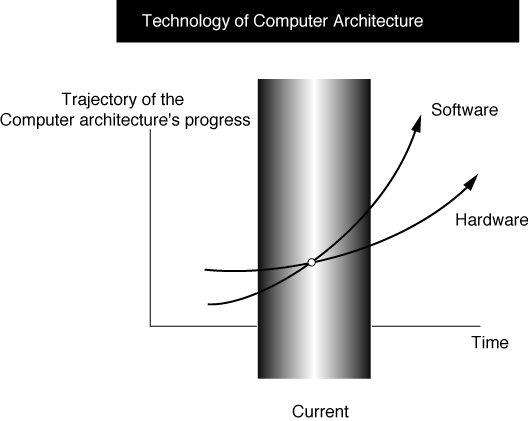
Fig. 6
Looking along the time axis, you can see that hardware could not meet software requirements during the early stages, even though researchers intended to try many things with software. In the first place, microchips were not available in those days. Even when chips were developed later, the number of elements was so small that software designs were severely limited. So, any improvement of hardware performance lead directly to the advancement of computer architecture at that time.
The performance of hardware has been dramatically enhanced and we no longer have that bottleneck in the computer architecture. Rather, it is becoming very hard to make full use of the present hardware performance. So, a new approach in which software design precedes hardware design will prevail soon. We stand at the turning point. De facto standards of computer architecture will be drastically changed when this new approach is widely practiced. Since we are standing at that turning point, it is very important to consider future development and trends, and conduct research and development accordingly. This has been a very abstract story, but it is definite that what has determined computer architecture in the past will soon be replaced with something else.
Now, I would like to wind up my speech by introducing the next speakers for the Real World Intelligence and the Parallel and Distributed Computing Technology sub-projects.
They are Dr. Nobuyuki Otsu and Dr. Junichi Shimada, both are candidates for leadership of their respective subcommittees. As I stated before, discussions on the research of the Parallel and Distributed Computing Technology sub-project is not finalized yet, partly due to delayed scheduling by MITI. Dr. Shimada will probably introduce thegIntegration of Parallel and Distributed System,hone of the research areas in the Parallel and Distributed Computing Technology sub-project.